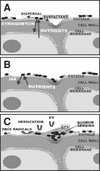Microbiology of the phyllosphere
- PMID: 12676659
- PMCID: PMC154815
- DOI: 10.1128/AEM.69.4.1875-1883.2003
Microbiology of the phyllosphere
Figures


References
-
- Andrews, J. H., and R. F. Harris. 2000. The ecology and biogeography of microorganisms on plant surfaces. Annu. Rev. Phytopathol. 38:145-180. - PubMed
-
- Bailey, M. J., P. B. Rainey, X.-X. Zhang, and A. K. Lilley. 2002. Population dynamics, gene transfer and gene expression in plasmids: the role of the horizontal gene pool in local adaptation at the plant surface, p. 173-192. In S. E. Lindow, E. I. Hecht-Poinar, and V. J. Elliot (ed.), Phyllosphere microbiology. APS Press, St. Paul, Minn.
-
- Bassler, B. L. 1999. How bacteria talk to each other: regulation of gene expression by quorum sensing. Curr. Opin. Microbiol. 2:582-587. - PubMed
-
- Beattie, G. A. 2002. Leaf surface waxes and the process of leaf colonization by microorganisms, p. 3-26. In S. E. Lindow, E. I. Hecht-Poinar, and V. Elliott (ed.), Phyllosphere microbiology. APS Press, St. Paul, Minn.
Publication types
MeSH terms
LinkOut - more resources
Full Text Sources
Other Literature Sources

